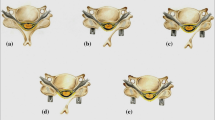Abstract
Purpose
To compare the stabilization behavior of additional unilateral mass screw fixation with current standard procedures in patients with cervical spondylotic myelopathy (CSM) in a biomechanical study.
Methods
Ten human C2–C7 cervical specimens were tested under various segment conditions: native (NAT), laminoplasty (LP), laminoplasty with unilateral (LPU) or bilateral (LPB) stabilization, laminectomy with bilateral stabilization (LCB), and laminectomy. The instrumented level was from C3 to C6. For each segment condition, in vitro flexibility tests were performed using a spinal simulator and an applied load of ±2.5 Nm. The three-dimensional kinematics of the entire cervical segment in three main loading directions [flexion–extension (FE), lateral bending (LB), and axial rotation (AR)] was measured with an ultrasonic motion analysis system. Analysis of variance followed by a post hoc test was used to determine differences under the specific segment conditions to assess the parameters range of motion (ROM) and neutral zone (NZ).
Results
For FE, the total ROM of laminoplasty (−6.3 % difference to NAT) and laminectomy (+6.4 %) remained at the level of native (p > 0.56), whereas the instrumentations LPU (−37.1 %), LPB (−44 %), and LCB (−43.2 %) lead to significant reductions (p < 0.01) without significant differences in LPU to LPB and LCB (p > 0.38). The same results were found with LB. For AR, the stabilization of all instrumentations was less pronounced, but had the same tendency seen for FE and AR. The results for the NZ showed equivalent values as that for ROM.
Conclusion
The degree of stabilization was as expected for LC and LCB; namely, no stabilization for LC and maximal stabilization for LCB. LPU exhibited almost the same degree of stabilization as LCB. LPU could be a new treatment option for less invasive decompression for multilevel CSM.



Similar content being viewed by others
References
Karadimas SK, Erwin WM, Ely CG, Dettori JR, Fehlings MG (2013) Pathophysiology and natural history of cervical spondylotic myelopathy. Spine 38:S21–S36
Bartels RHMA, van Tulder MW, Moojen WA, Arts MO, Peul WC (2015) Laminoplasty and laminectomy for cervical spondylotic myelopathy: a systematic review. Eur Spine J 24(Suppl 2):160–167
Roselli R, Pompucci A, Formica F, Restuccia D, Di Lattaro V, Valeriani M, Scerratis M (2000) Open-door laminoplasty for cervical stenotic myelopathy: surgical technique and neurophysiological monitoring. J Neurosurg 92:38–43
Nakashima H, Imagama S, Yukawa Y, Kanemura T, Kamiya M, Yanase M, Ito K, Machino M, Yoshida G, Ishikawa Y, Matsuyama Y, Hamajima N, Ishiguro N, Kato F (2012) Multivariate analysis of C5-palsy after cervical posterior fusion with instrumentation. J Neurosurg Spine 17:103–110
Nassr A, Eck JC, Ponnappan RK, Zanoun RR, Donaldson WF, Kang JD (2012) The incidence of C5 palsy after multilevel cervical decompression procedures. A review of 750 consecutive cases. Spine 37:174–178
Liu K, Shi J, Jia L, Yuan W (2013) Surgical technique: hemilaminectomy and unilateral lateral mass fixation for cervical ossification of the posterior longitudinal ligament. Clin Orthop Relat Res 471:2219–2224
Magerl F, Grob D, Seemann PS (1987) Stable dorsal fusion of the cervical spine (C2–T1) using hook-plates. In: Kehr P, Weidner A (eds) Cervical spine I. Springer Verlag, New York, pp 217–221
Wilke HJ, Wenger K, Claes L (1998) Testing criteria for spinal implants: recommendations for the standardization of in vitro stability testing of spinal implants. Eur Spine J 7(2):148–154
Crawford NR, Brantley AG, Dickman CA, Koeneman EJ (1995) An apparatus for applying pure nonconstraining moments to spine segments in vitro. Spine 20:2097–2100
Panjabi MM, Oxland TR, Yamamoto I, Crisco JJ (1994) Mechanical behavior of the human lumbar and lumbosacral spine as shown by three-dimensional load-displacement curves. J Bone Joint Surg Am 76:413–424
Panjabi MM, Malcolmson G, Teng E, Tominaga Y, Henderson G, Serhan H (2007) Hybrid multidirectional test method to evaluate spinal adjacent-level effects. Clin Biomech 22:257–265
Subramaniam V, Chamberlain RH, Theodore N, Baek S, Safavi-Abbasi S, Senoglu M, Sonntag VKH, Crawford NR (2009) Biomechanical effects of laminoplasty versus laminectomy. Stenosis and stability. Spine 34:E573–E578
Kode S, Gandhi AA, Fredericks DC, Grosland NM, Smucker JD (2012) Effect of multilevel open-door laminoplasty and laminectomy on flexibility of the cervical spine: an experimental investigation. Spine 37:E1165–E1170
Kothe R, Rüther W, Schneider E, Linke B (2004) Biomechanical analysis of transpedicular screw fixation in the subaxial cervical spine. Spine 29:1869–1875
Dmitriev AE, Kuklo TR, Lehman RA Jr, Rosner MK (2007) Stabilizing potential of anterior, posterior, and circumferential fixation for multilevel cervical arthrodesis: an in vitro human cadaveric study of the operative and adjacent segment kinematics. Spine 32:E188–E196
Bilsky MH, Laufer I, Fourney DR, Groff M, Schmidt MH, Varga PP, Vrionis FD, Yamada Y, Gerszten PC, Kuklo TR (2010) Reliability analysis of the epidural spinal cord compression scale. J Neurosurg Spine 13:324–328
Riesenburger RI, Potluri T, Kulkarni N, Lavelle W, Roguski M, Goel VK, Benzel EC (2012) Unilateral cervical facet dislocation: a biomechanical study of several constructs including unilateral lateral mass fixation supplemented by an interspinous cable. J Neurosurg Spine 16:251–256
Schmidt R, Koller H, Wilke HJ, Brade J, Zenner J, Meier O, Ferraris L, Mayer M (2010) The impact of cervical pedicle screws for primary stability in multilevel posterior cervical stabilizations. Spine 35:E1167–E1171
Acknowledgments
This study was supported in part by a research grant from the Deutsche Arthrose-Hilfe and the World Arthrosis Organization. Implants and instrumentations were provided by Aesculap AG, Tuttlingen, Germany.
Author information
Authors and Affiliations
Corresponding author
Ethics declarations
Conflict of interest
We have no potential conflict of interest.
Rights and permissions
About this article
Cite this article
Schmeiser, G., Schilling, C., Grupp, T.M. et al. Unilateral laminoplasty with lateral mass screw fixation for less invasive decompression of the cervical spine: a biomechanical investigation. Eur Spine J 24, 2781–2787 (2015). https://doi.org/10.1007/s00586-015-4230-5
Received:
Revised:
Accepted:
Published:
Issue Date:
DOI: https://doi.org/10.1007/s00586-015-4230-5




